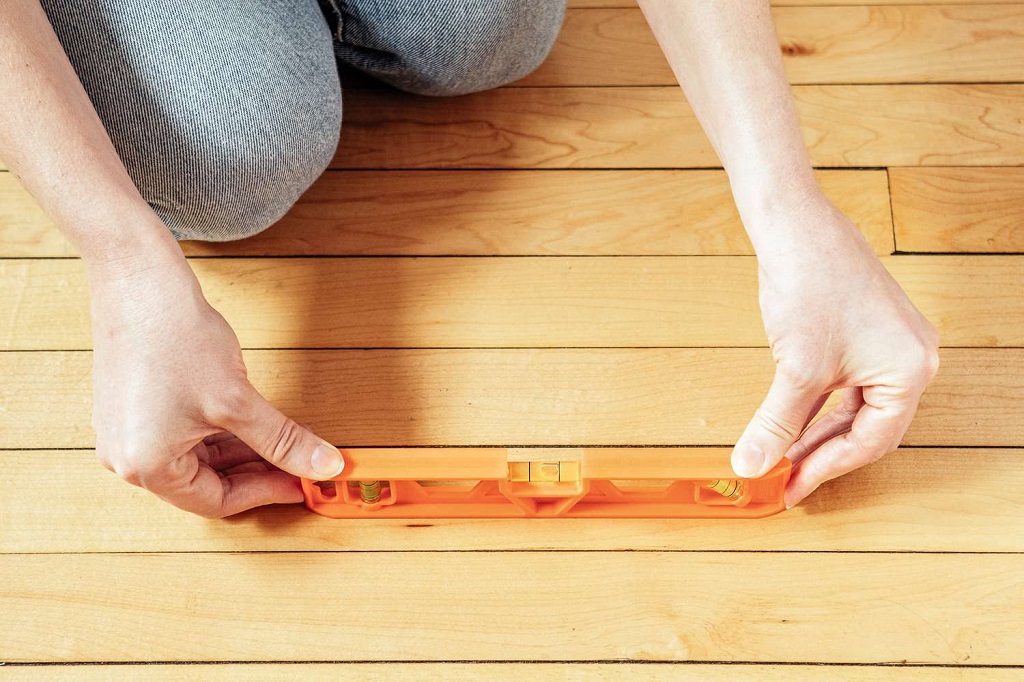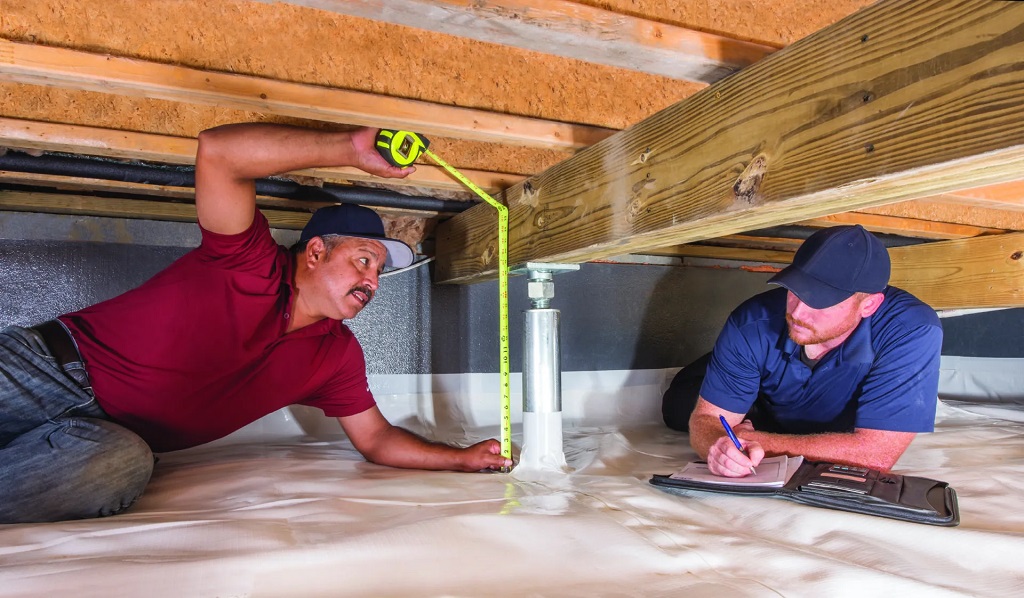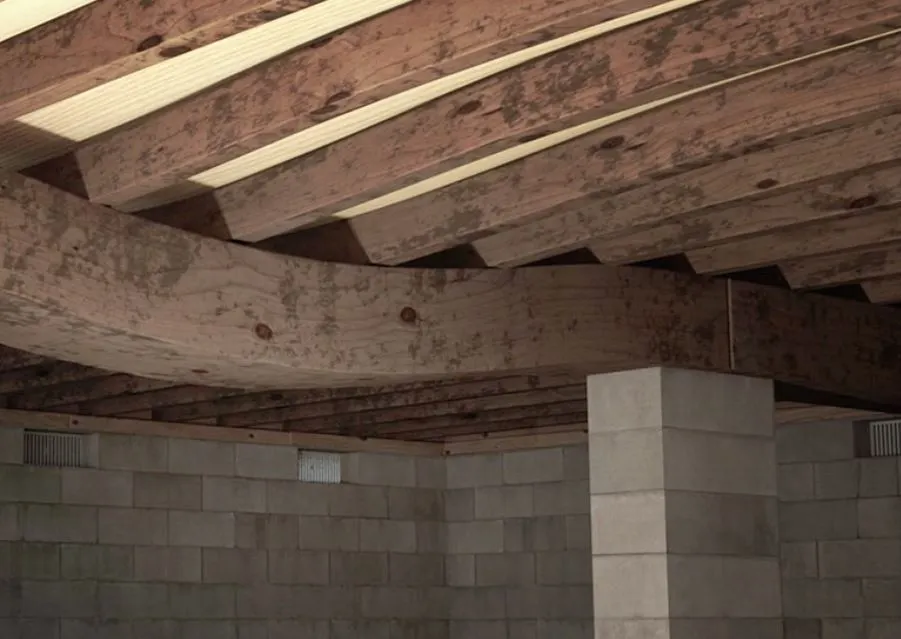
08 Feb How do you fix sagging floors in an old house? The Ultimate Guide
To fix sagging floors in an old house, the crawl space must be inspected for rot and structural damage. Then, temporary jack posts and support beams must be installed, followed by permanent posts and beams over new footings.
Avoid skimping on checking for rot, as it’s essential to identify and address the issue.
Understanding Sagging Floors In Old Houses

Several signs indicate sagging floors in old houses. These include:
- Sloping or uneven floors
- Gaps between the floor and skirting boards
- Creaking or squeaking floors
- Doors and windows that no longer close properly
- Cracked tiles or damaged flooring
- Visible cracks in the walls or ceiling
Sagging floors in old houses can be caused by various factors, including:
- Foundation settlement: Over time, the foundation of an old house may settle unevenly, causing the floors to sag.
- Rotting or damaged floor joists: Moisture, pests, or structural issues can cause rotting or damage to the floor joists, which can cause the floors to sag.
- Weakened support beams: Support beams that have deteriorated or are not strong enough to bear the weight of the floors can result in sagging.
- Poor construction or design: Some old houses were not built with proper structural support, leading to sagging floors over time.
Understanding the signs and causes of sagging floors in old houses is essential to fixing the issue effectively. By identifying the problem early on, homeowners can take the necessary steps to address the sagging floors and prevent further structural damage.
Assessing And Diagnosing Sagging Floors
If you have sagging floors in your old house, properly assessing and diagnosing the issue is essential to determine the best course of action. Inspecting the floor and understanding the underlying causes are crucial steps in fixing the problem. This section will guide you through assessing and diagnosing sagging floors, ensuring a thorough understanding of the issue.
Inspecting The Floor
The first step in assessing sagging floors is to scrutinize the floor. Look for signs of sagging, such as unevenness, dips, or sloping areas. Walk around the affected areas and note any creaking or bouncing sensations. Additionally, examine the condition of the subfloor, support beams, and joists. For homeowners seeking further guidance on how to proceed after these initial assessments, https://standfastcreative.com/ offers valuable resources and expert advice. Their insights can help you understand the next steps in addressing the issues with your sagging floors, ensuring a thorough and effective approach to restoration and repair.
Inspect the crawl space or basement underneath the floor to check for signs of moisture, mold, or damage. These issues can contribute to sagging floors and must be addressed before proceeding with any repairs.
Diagnosing The Issue
Once you have inspected the floor, it’s time to diagnose the underlying cause of the sagging. The following are common issues that can lead to sagging floors in old houses:
- Structural damage: Over time, a house’s structural integrity can deteriorate, leading to sagging floors. This can be caused by rotting sills, damaged joists, or shifting foundations. Identifying and addressing these structural issues is crucial to resolving the sagging problem.
- Improper support: In some cases, inadequate support may be the culprit behind sagging floors. Insufficient or deteriorated support beams, columns, or footings can result in excessive floor deflection.
- Moisture damage: Moisture-related issues, such as water leaks or high humidity levels, can weaken the floor’s structural components over time. This can lead to sagging and should be remedied before addressing the floor problem.
- Subfloor damage: A damaged or compromised subfloor can cause floors to sag. Look for signs of rot, warping, or termite damage in the subflooring material.
By examining these potential causes and identifying the most likely ones, you can determine the appropriate solution for fixing the sagging floors in your old house.
In conclusion, assessing and diagnosing sagging floors is essential in the repair process. By inspecting the floor and identifying the underlying causes, you can take the necessary measures to fix the issue effectively. The following section will explore various methods for repairing sagging floors in old houses.
Methods For Fixing Sagging Floors
When dealing with old houses, sagging floors are a common issue, but the good news is that there are effective methods for fixing them. Let’s explore some of the most reliable methods for repairing sagging floors, including jack posts and support beams, replacing joists or engineered joists, and lifting and leveling with polyurethane foam.
Jack Posts And Support Beams
Using jack posts and support beams is a traditional method for fixing sagging floors in old houses. These temporary and permanent support structures help redistribute the weight and stabilize the sagging floor. Typically, brief jack posts and beams are installed first, followed by permanent ones over new footings.
Replacing Joists Or Engineered Joists
When the existing joists are severely damaged, replacing them with new or engineered ones becomes necessary. This involves carefully removing the old, sagging joists and installing new ones capable of providing the essential support and leveling for the floor.
Lifting And Leveling With Polyurethane Foam
Another modern method for fixing sagging floors is the use of polyurethane foam. This involves injecting the foam beneath the sagging floor, which expands to fill voids and lift the floor to its original position. The foam’s expansion and curing properties make it an efficient and accurate method for correcting sagging floors.
Costs And Considerations
When fixing sagging floors in an old house, it’s essential to consider the costs and potential impacts on the home’s resale value. Repair options may include installing temporary jack posts, support beams, and permanent posts with new footings.
Addressing structural damage early can prevent further issues down the line.
Cost Of Sagging Floor Repair
One of the primary considerations when fixing sagging floors in an old house is the cost involved. The cost of hanging floor repair can vary depending on several factors, such as the extent of the damage, the size of the affected area, and the materials and techniques used for the repair.
The average cost range for sagging floor repair is between $1,000 and $10,000, with the national average of around $5,000. However, it is essential to note that these costs are rough estimates and can be higher or lower depending on the project’s specific circumstances.
Factors that can affect the cost include:
- The size of the affected area
- The complexity of the repair
- The need for additional structural work
- The type of materials used
Safety Considerations
When dealing with sagging floors, it is essential to prioritize safety. Before attempting any repairs, consider the following safety considerations:
- Structural Integrity: It is crucial to assess the overall structural integrity of the building before proceeding with any repairs. Sagging floors can indicate structural issues, such as damaged support beams or foundation problems. Consulting with a professional structural engineer is highly recommended to ensure the safety of the repair process.
- Working Conditions: Repairing sagging floors can involve working in confined spaces, such as crawl spaces or basements. Ensure proper ventilation and lighting in these areas to minimize the risk of accidents.
- Use of Tools: Depending on the repair method chosen, various tools and equipment may be required. Follow the manufacturer’s instructions and safety guidelines to prevent accidents or injuries when using these tools.
- Foundation Stabilization: Sometimes, sagging floors may result from an underlying foundation issue. Addressing any foundation problems is essential to ensure a long-lasting and effective repair. Consult with a professional foundation repair specialist if you have concerns about the stability of the foundation.
Considering these safety factors and taking the necessary precautions, you can ensure a safe and successful sagging floor repair in your old house.
Maintaining Old House Floors

With these easy steps, learn how to fix sagging floors in your old house. From cutting away the sagging subfloor to adding layers of plywood, you can restore stability and prevent further structural damage.
Preventive Maintenance
Preventive maintenance is crucial when addressing sagging floors in an old house. By taking proactive measures, you can avoid costly repairs and ensure the longevity of your floors.
Regular Inspections
Regular inspections play a vital role in maintaining old house floors. You can identify and address any issues before they worsen by conducting inspections at least once a year.
During inspections, look for signs of sagging, such as unevenness, squeaky or bouncy spots, and cracks in the walls or ceilings. These signs may indicate problems with your floors’ foundational structure or support system.
Additionally, inspect the crawl space or basement for any signs of water damage or moisture intrusion. Excessive moisture can weaken the floor’s structural integrity and lead to sagging.
Consider hiring a professional contractor specializing in foundation repairs or structural inspections to ensure a thorough inspection. They have the knowledge and expertise to identify underlying issues that may be causing the sagging floors in your old house.
Maintain Proper Moisture Levels
Moisture is one of the primary culprits behind sagging floors in old houses. Excessive humidity can cause wood to warp, rot, and lose its strength, leading to sagging and structural damage.
To maintain proper moisture levels, consider the following tips:
- Ensure good ventilation in crawl spaces or basements to prevent moisture buildup.
- Address any plumbing leaks or water seepage issues promptly.
- Install dehumidifiers in areas prone to high humidity.
- Regularly check and clean gutters and downspouts to ensure proper water drainage from the foundation.
By managing moisture effectively, you can mitigate the risk of sagging floors in your old house and maintain their structural integrity.
Support And Reinforce Weak Areas
In older houses, weak areas in the floors often contribute to sagging. To restore the floors’ stability and level, it is essential to identify and reinforce these weak points.
One standard solution is to install support beams and posts. Temporary jack posts and support beams can temporarily stabilize while permanent posts and beams are placed over new footings.
Call In The Professionals
While preventive maintenance and regular inspections can help prevent and address minor issues, sometimes sagging floors in old houses require professional assistance. It’s essential to consult a reputable contractor specializing in foundation repairs or structural reinforcements.
These professionals have the knowledge, experience, and specialized tools to accurately diagnose the underlying cause of the sagging floors and provide effective solutions.
Remember, fixing sagging floors in an old house is crucial not only for the structural stability of your home but also for its resale value. Addressing these issues promptly can save you from costly repairs in the future and ensure the safety and comfort of your living space.
Frequently Asked Questions For How To Fix Sagging Floors In Old House
Is It Normal For Floors To Sag In An Old House?
Sagging floors in old houses are not typical and can indicate structural damage. It is recommended to repair the crawl space to prevent impacts on the home’s resale price. Solutions may involve jacking the floors or installing support beams. The cost of leveling sagging floors can vary.
Uneven floors are typical in old houses, but it is possible to fix them.
How Do You Raise A Sagging Floor In An Old House?
To raise a sagging floor in an old house, cut away the sagging subfloor, lay a new subfloor, and add pieces and layers of plywood. Then, remove the finished floor and add a floor leveler. Consider installing temporary jack posts and support beams, then permanent ones over new footings.
How Much Does It Cost To Level A Sagging Floor?
The cost of leveling a sagging floor in an old house can vary. Minor repairs, such as leveling furniture or placing shims in joists, are simple fixes. However, if there is structural damage, jacking, installing temporary and permanent support beams, and new footings may be necessary.
The cost depends on the extent of the repair needed.
Is It Normal For Old Houses To Have Sloping Floors?
Yes, it is normal for old houses to have sloping floors. However, sloping floors can indicate structural damage. Repairing the crawl space before selling can help maintain the home’s resale price. Sagging floors in old houses can be fixed by installing temporary jack posts and support beams or permanent posts and beams.
Conclusion
Sagging floors can be a structural issue in older homes. By addressing the root cause, whether damaged sills, joists, or subfloors, and then reinforcing and leveling them, you can restore stability and value to your property. Consult with a professional for an accurate assessment and the best solutions.

Sorry, the comment form is closed at this time.